The British love cream in all its varieties, from clotted cream to double cream to Devonshire cream (or Devon cream), to Cornish clotted cream and many other varieties. It’s enough to make your head spin, and it’s particularly confusing if you’re an American trying to follow a British recipe. I recently ran into this problem when I was trying to make a delicious-looking and –sounding lemon tart that was featured on an episode of “How to Cook Like Heston” with Heston Blumenthal. It called for double cream, which sent me on a quest to figure out: can I just substitute heavy whipping cream for double cream? The answer is no. But I have found a solution…
A Cream Maker.
I actually started looking into this gadget several years ago, but never bought one because they were mostly offered on the UK version of eBay, and the shipping was prohibitively expensive. This is a simple, old-fashioned gadget that does its one job perfectly, and that job is to make double cream (or single cream or extra thick double cream or any of the other varieties of cream) out of plain old milk and unsalted butter. Basically, it re-homogenizes the fat into the milk. It came into popular use during World War II, when rationing led to cream becoming almost impossible to find. People could get their standard ration of milk and butter, but no cream. Since butter is nothing but milk fat that has been separated from the liquid portion of the milk, it stands to reason that putting the butter back into the milk would reconstitute the cream, but the process is tricky. You can’t just stir it together, because the melted butter floats. You can’t shake it together, because that is actually how the butter is created in the first place—shaking only forces the sticky butter to cling together. What you can do is force the liquid butter and milk through a fine nozzle a bit at a time under pressure, and this will recreate the original cream.
I finally found an old Bel Cream Maker on eBay in the US, and it looked completely unused. I was excited to give it a whirl when it arrived in the mail today. I washed and assembled the parts, and followed the directions in the accompanying original brochure, and I soon had extremely thick double cream! I document the recipe and procedure below.
If you want to buy one of these gadgets for your own use, here are some tips: they were most commonly made by a company called Bel. You can also find an attachment for a Kenwood mixer that does the same things, but that’s only helpful for people who have such a mixer. Anybody can use one of the Bel cream makers. When searching on eBay, you find a wide range of conditions and prices. These usually go for around $10 to $20 US, but I’ve seen sellers who think they can get $50 to $300 for them just because they are cute and vintage. I can assure you there is no need to pay that much! Several of these come up for sale each week, so just be patient and check back and you’re bound to be rewarded.
You will find many more “ice cream makers” than cream makers, so it’s best to find a way to filter those out. One of the Bel models was called the Jubilee, and many of the older models are made of Bakelite, so the best search I found was the following (leave all punctuation and spacing intact):
(bel,jubilee,Bakelite) “cream maker”
What this search is telling eBay, just in case you don’t know how eBay advanced search works, is: show me any items that have any of the words bel, jubilee, or Bakelite AND the words “cream maker” in exactly that order. In essence, this gets rid of the glut of whipped cream makers and ice cream makers so you don’t have to wade through them. Now on to the Recipe (*see note at the end regarding different measurements or percentages of butterfat–one of my helpful readers actually created a calculator that I will link to)!
Double Cream Recipe:
Double Cream is 48% milkfat. The highest percentage milkfat available in the US is typically 36%, so it doesn’t substitute. Once you have your cream maker in hand and assembled and ready to go, follow these steps:
Weigh or measure out:
4 fluid ounces of milk (100 ml)
5 ounces of UNSALTED butter (you don’t want salty cream, do you?) (140g), cut in pieces
Put these two ingredients together in a small saucepan and heat gently over low to medium heat. You do not want to boil or scorch your milk because it will change the flavor. If you keep the temperature below 180 degrees F, that is best. You can remove it from the heat once the butter is about halfway melted and the residual heat will continue melting it. Once it has been completely melted, stir it and then quickly pour it into your cream maker. Next, hold the maker FIRMLY with one hand (you need to pump the handle of the thing up and down with some force, so you will need to keep a firm grip on the base of the thing to prevent any spills). Pump the handle. If nothing is coming through into the chamber below after a few pumps, stop pumping, carefully take off the lid from the base, and adjust the nozzle nut by loosening it slightly. Reassemble and start over. Once you see something coming through (you should probably see about ½ teaspoon of cream being created with each pump), continue pumping until all of the milk and cream have been forced through into the lower chamber of the cream maker. Congratulations! You just made Double Cream!
Here are some photos I took while I was making my first batch, along with some photos of the resulting THICK cream (it became much thicker after cooling):
The box my Bel Cream Maker came in (mine seems to be from around the 1970’s, which is around the time the company stopped making this item, it seems, judging from availability).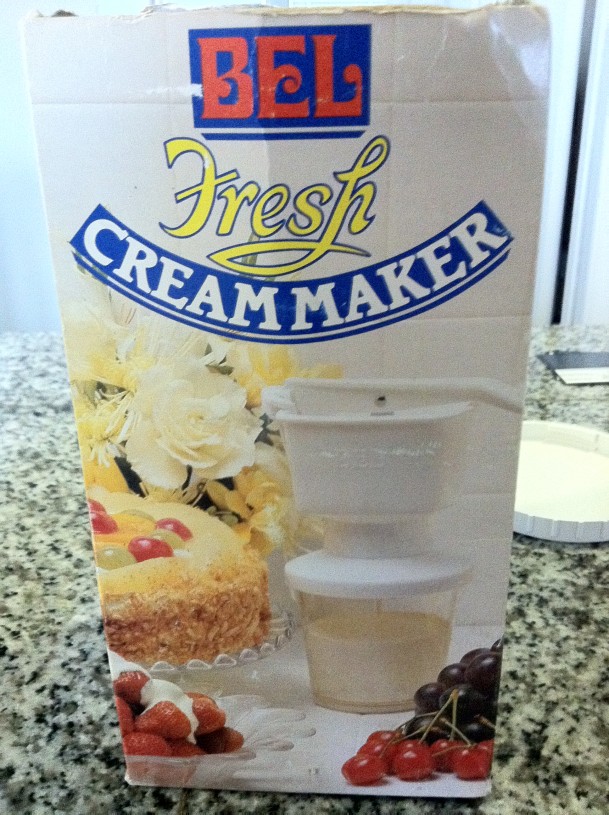
Melting the butter. After heating it up and removing if from the heat, you can let it sit for a few minutes. You can see some of the remaining small pieces of butter sitting in little yellow pools of melted butter. Once you stop seeing those little pools of melted butter appear, your butter is ready to go.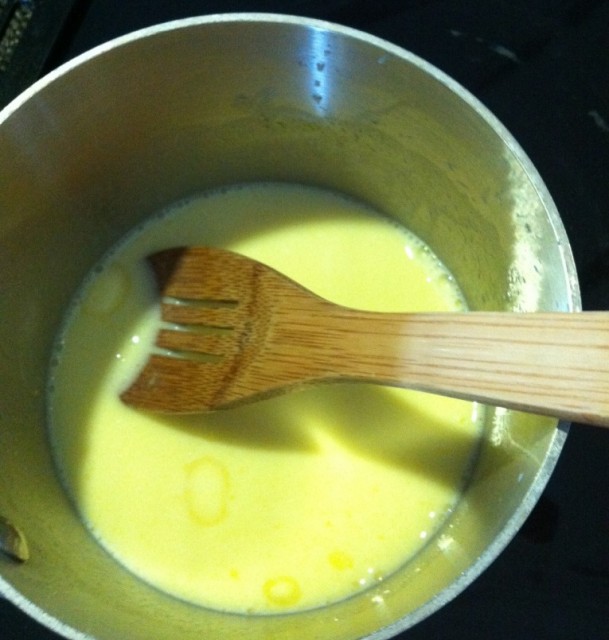
All melted, no more pools of yellow butter on top: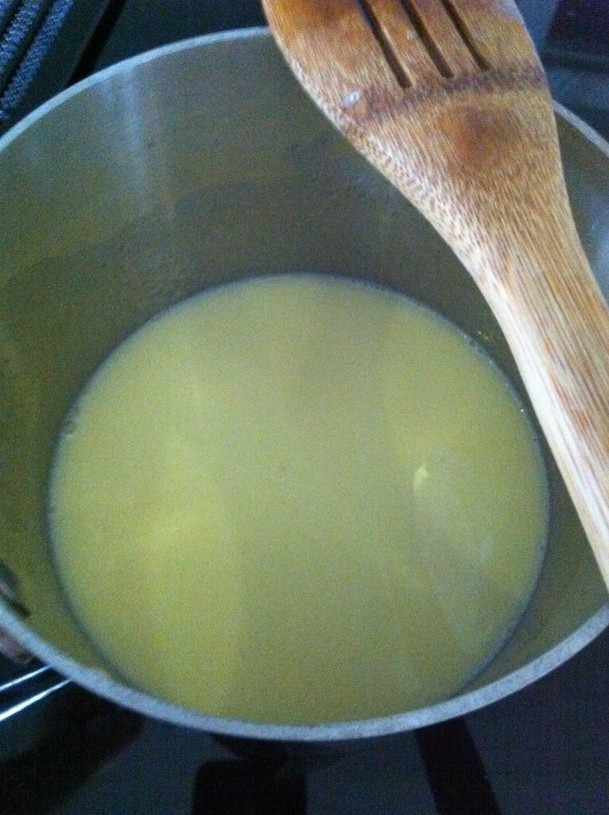
Poured into the Bel Cream Maker: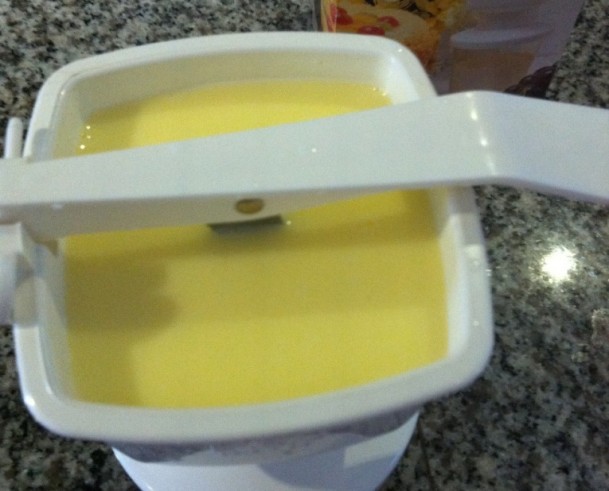
All done. The final product. This cream is about twice as thick as American Heavy Cream. I can’t wait to try the Heston Blumenthal Lemon Tart recipe (it appeared on Episode 2 of “How to Cook Like Heston”, the “Eggs” episode). One commenter pointed out that the cream looks a little thin. Please remember that it was still warm in this photo, and it thickened considerably after being chilled.
Of course, the tart recipe is not one of my normal Primal Recipes. It’s one of my “cheat day” recipes. I plan to use the eggs from my amazing French Marans hens to make this incredibly rich looking custard tart. Can’t wait to try it. If it’s as good as I hope, I’ll share the recipe.
*Note on measurements and percentages of butterfat: I have had many questions from readers regarding different percentages of butterfat, or what they could subsitute to come up with the preferred 48% of double cream. One of my readers, Matt, actually made a calculator that will help you with any such questions! You can find it here. It will open up pre-populated with 80% butterfat (the percentage in plain butter) and 3.25% fat (for whole milk). If you are using this calculator, you will want to leave the 80% for butter, but you could change the milk fat percent to 12% for half-and-half, or 0% for skim milk, 1% for 1% milk, etc. You can even change the desired volume, depending on how much double cream you need. Very handy! Thanks, Matt, whoever you are!
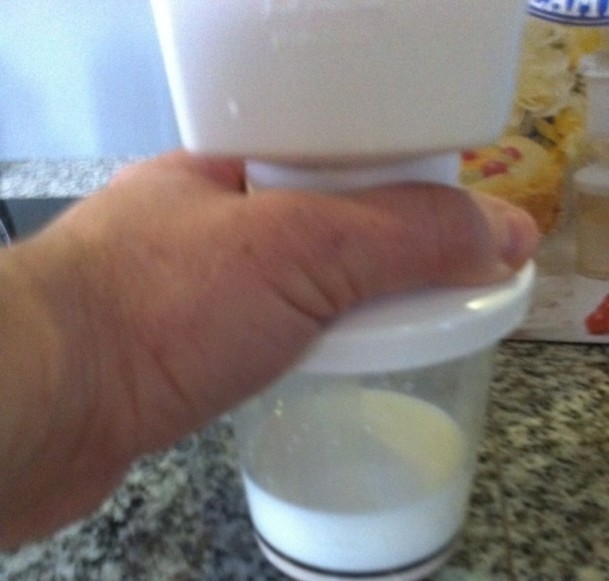
Monifah, the recipe is actually extremely close to the original constitution of double cream, which is of course a milk product that contains both milk and milk fat. You can use organic milk if you choose, or you can use whatever you have handy. Depends on your personal requirements and preferences, and what you can find at your local store!
thanx for this i have one that was my grandmas based on this recipe it is exactly what i was looking for thanx again my friend
Whole milk, or can I use 2%, which is what I usually buy for daily use?
Christine, since whole milk is usually about 5% butterfat and you know the milk you use is 2%, you can of course use the 2%, but you would need to add a slightly larger amount of butter to make up the extra 3%. You could do the math to figure the ratios exactly, but I would probably just add another tablespoon or so of butter and go for it.
This looks very thin compared to the UK versions I have had (typically it doesn’t pour out of a spoon). Curious if you have actually had/used British double cream and if so how does the taste compare? We purchase the double Devon cream in the jar but it is ranges in price from $5 to $7 which is expensive for a recipe.
This is a fresh product and it is not meant to replace clotted cream, which is a different thing entirely. Double Devon Cream is a clotted cream product that is usually shelf stable. Double cream would be sold in the refrigerated section with the dairy. The photo was also taken while the mixture was still hot. It did thicken up quite a bit after cooling.
I have had double cream from a specialty store. You have to realize that the photo shows the cream while it is still warm. It thickened up much more once it was chilled. But I didn’t remember to take any photos of that.
Could I use reg American cream, IE use it as milk, to make the cream?
Sam, you could certainly do so, but you would just need to do some calculating based on the fat percentage of the cream available in your area. Basically, melted butter is usually between 80-85% fat (with the remainder being mostly plain water, with a tiny amount of milk solids), while whole milk is 5% fat. If your cream is around 36% butterfat, and the goal is to make it 48% butterfat (which is closer to British double cream), you would need to add an additional 12-15% or so of melted butter to your cream (by volume of the amount of cream you are using), in order to attain your desired consistency.
This could make double cream which can be mixed with US heavy cream to make a more stabilized frosting cream for Chinese or Korean fruit cakes right?
Angus, can you help me with the math.. 🙂 How do you calculate how much milk and butter you need exactly? I live in a small Eastern European country and both heavy cream and double cream are impossible to find here. It would also be harder for me to use recipes from the Internet because the fat content in butter and milk here is different. I recently bought an ice cream machine and making ice cream calls for using either heavy or double cream. I’m thinking about getting the Jubilee from the British eBay so I need a little bit of advice. Thanks!
Let’s not work too hard with the math, and make this easy on ourselves with a quick experiment.
Whole milk is about 4% fat and butter is 80% fat.
This means 100g of milk has 4g of fat, and 100g of butter has 80g of fat.
If we threw 100g of each into a bowl, you would have 200g of liquid that has 84g of fat, which is 42% (84/200), So, we’re already pretty close. I said this wasn’t hard.
What would happen if we added 50% more butter.
We would have (100 + 150)=250g of liquid with (4g + 120g)=124g of fat, which is about 50% fat (124/250).
This would be extra rich double-cream, and very easy to remember, 1 to 1.5.
So, for those that want to get closer to 48%, (100g of milk with 4% fat) + (140g of butter with 80% fat) is 4g + 112g = 116g of fat inside 240g of liquid which is 116/240 = 48.3% fat.
Therefore, to make double cream, for every 1 gram of milk, you need 1.4 grams of butter.
If you prefer whole numbers, for every 2 units of milk, you need almost 3 units of butter.
I hope that wasn’t too painful.
For our number lovers, percentage of fat is the sum of the fat by weight divided by the total weight.
Given: All measurements are by weight. M = Milk, B = Butter.
Then: %fat = [(M x .04) + (B x .80)] / (M + B)
FYI:
.80 – .85 Sweet Cream Butter
.43 – .48 Double Cream
.30 – .40 Crème Fraiche
.36 – .38 Heavy Cream
.30 – .36 Whipping Cream
.18 – .30 Light, Coffee or Table Cream
.18 – .30 Sour Cream
After thinking about how to approach it I decided to use a system of two linear equations: 0.7x + 0.03y=0.4(x+y) & x+y=220 (butter and milk fat percentages here are a bit different and I also assumed a 40% fat content in the final product). Got the same results, as expected. Thanks for your post!
Hi — I just got a Bel Cream Maker and made my first batch. I didn’t have milk, so I used 4 0z of heavy cream (pasteurized and homogenized, but from a dairy, not from a grocery store, so not UHP) and 4 oz of butter. It’s still cooling, but it seems too buttery and not thick enough (when comparing with the taste and texture of English single and double cream, with which I am very familiar).
I can’t figure out all that math stuff that other people posted — any chance of a recipe/proportion for making the thickest cream possible (double cream or extra double cream style) using heavy cream from a dairy?
Thanks!
I went ahead and made a calculator that you can use. It’s not pretty, but it gets the job done for me, so maybe some of you will find it helpful as well.
Oh, thank you, thank you. I have a machine inherited from my mum in which she used to make the most delicious cream and I have been trying to find recipes. All I could find were ice cream recipes so I am so happy to have found you!
Thank you so much for this fantastic post. I am from the UK and when I moved to Kuwait I was surprised to discover there is no such thing as double cream over here. I began researching about different types of cream and like you said it sent my head into a spin! I was about it give up my cooking dreams when I discovered this page. I have bookmarked it and will most certainly be trying to make this some time soon 🙂
Very well written. I Stumbled across this page while looking for a cream maker. What a great find!! So much information. Now I really have to have creamer… You make it look so easy. Thanks so much for all your research.
What year is the Bel Cream Maker?
I am literally in tears at this find; this may improve my life considerably. You see, I am allergic to cow’s milk (and beef, just everything about cows in general). In American, NOBODY sells goat’s milk cream. Just nobody. Our goat dairies are all dedicated to the production of cheeses, and the very few rare companies that sell goat’s milk commercially do not bother with cream separation. So for years, I’ve just been completely up the creek as far as any cream product, and I’ve learned that you can not, in fact, whip evaporated goat’s milk no matter how cold it is, period. I am going to try to get my hands on a cream maker and see if I can make cream with goat’s milk and goat milk butter, which I CAN buy. If this works it will re-open a whole world of cooking options that I thought were closed to me forever. Wish me luck!!!
Good Luck! And please let me know if it works!
You are a god! I just received almost every book in the Great British Baking Show (or Bake Off, to those overseas) as well as a bunch of books by Mary Berry and there are so many recipes calling for pouring double cream that I despaired of ever making anything from the books. I decided to look into making my own cream and there’s so little current information that it’s depressing. The first article I looked at got me excited until I saw it was from 1984 and its ordering information was obsolete. I ended up tracking down the Bel Fresh Cream Maker on ebay (thank you, UK sellers!)and if I have any luck making my own cream and modifying them for recipes I will definitely invest in a second Bel, just to make sure I have one on hand if the first goes kaput.
Also, a bit shout out goes to Matt for creating the calculator. Thank you!
Is there a calculator that increases butterfat percent in cream by combining cream and butter versus cream and milk?
I recently purchased a jubilee Cream maker and it has obviously been sitting up for years and needs to be dissembled, cleaned, & sanitized before use. Problem is i cant find any documentation anywhere as how to clean this unit. Can anyone help?
Thanks for this resource. I had only found one other site for instructions on making double cream. I already have my BEL maker on the way, and will soon be enjoying a much more true-to-recipe version of this highly recommended ice cream: https://www.nigella.com/recipes/vin-santo-ice-cream-with-cantuccini
And thanks to Matt for the calculator; it’s invaluable. Question for anyone who has tried different milks: in your experience, do the lower fat milks or the higher fat milks work better? My intuition is that starting with a higher fat cream should be easier, but perhaps not?
Thank you for all of this wonderful information and thank you, Matt for the amazing calculator!!!
I am wondering if I run down to my local raw milk dairy and simply separate the cream by letting it rise to the top if that is considered “double cream” or not. Do I still need to do this process? TIA.